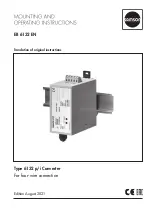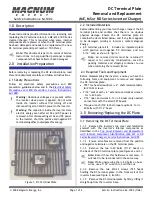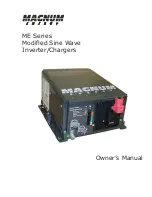
- 7 -
Temperature Sensor
(must be connected to allow operation of the unit):
The temperature sensor controls the
battery temperature of the board battery
and must be connected to the
terminals
"Temp. Sensor T T"
(any polarity).
Installation Temperature Sensor:
The
thermal contact
of sensor and
inside
temperature
of the battery
should be well.
Thus, it should be screwed
down to the
negative pole
of the battery, particularly in case of LiFePO batteries, since in most of the cases, this is the
cooler side (the positive pole is often biased by the exhaust heat of internal fuses, electronic systems for cell
equalization etc.). Ensure that the installation place is not influenced by any source of heat (engine block, exhaust,
heater etc.).
Function:
Battery protection, also refer to characteristic lines
"Charging Voltage Rates and Temperature
Control Battery I ":
In case of abnormal battery temperatures, such as < -20 °C, >50 °C, the charging voltage will be reduced strongly to
the
safety charging voltage
12.80 V for battery protection, and the maximum charging current rate will be halved. The
LED
"Battery I"
will be
flashing
.
Battery charging is then interrupted, but the supply of the connected consumers 12 V can be continued by the
charging converter. The battery is allowed to cool down and will not be discharged appreciably. Any charging data
being recorded hitherto will be kept in memory. The automatic charging will be resumed, as soon as the battery
temperatures are normal.
After more than 10 hours overtemperature of >50 °C a forced disconnection of the unit will be effected for reasons of
safety.
Below 0 °C, the charging current will be reduced more strongly for battery protection
and longer charging
times can be expected.
The unit recognizes automatically a missing sensor, cable break or short-circuit of the sensor cables, as well
as unreasonable measuring values. An automatic disconnection will be effected for reasons of safety, the
LED
"Main Charging"
will be flashing!
Option: Remote Control
(Tip Jack "Remote Control")
If the charging converter had been installed in a difficult to access location, the
remote control S
for automatic charger, order No. 2075,
allows remote control of the charging process
(plug-and-
go connection cable of 5 m length is included in the standard delivery scope).
Connection:
Connect the remote control to the tip jack "Remote Control".
Function:
The remote control is equipped with the same pilot lamps (light-emitting diodes) as the charging
converter.
Switch Function:
Position "ON": Charging converter works with full charging capacity. LED display is active.
Position "OFF": Charging converter is switched-off (stand-by).
Option:
Several Batteries at the Charging Port I:
Parallel charging of two or several batteries of the same voltage is admissible.
According to the battery manufacturers,
permanent
parallel operation is admissible in case of two or several batteries
of the same manufacturer, voltage, type, capacity, as well as of the same age (history) in cross connection.


































